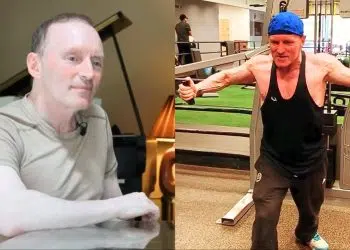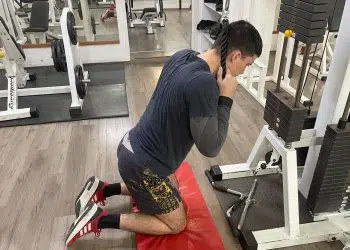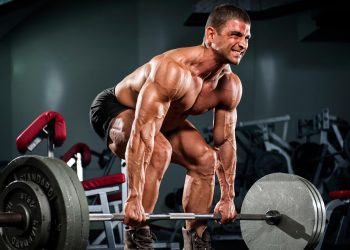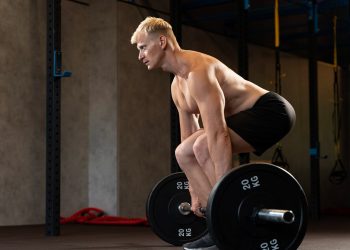If you’re looking for another way to train your hamstrings and posterior chain (muscles on the backside of the body) muscles aside from lying machine hamstring curls then you should keep reading.
The inverse leg curl (bench support) uses your own body weight to work the hamstrings and is just as, if not more challenging to do (depending on the equipment). It’s not a beginner’s exercise in its most basic form as doing it wrong can cause pain and injury.
In this guide, we’ve explained how to do it properly with tips, variations, and more so you can add it to your lower body routine.
In This Exercise:
- Target Muscle Group: Hamstrings
- Type: Hypertrophy, strength
- Mechanics: Isolation
- Equipment: Support bench
- Difficulty: Intermediate/advanced
Muscles Worked
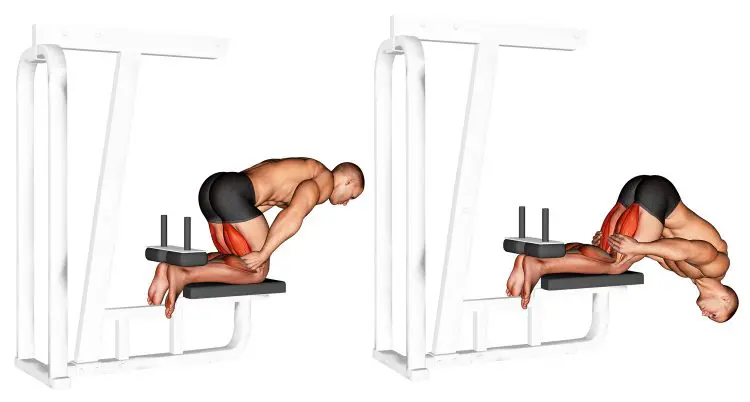
Hamstrings
The hamstrings is a multi muscle body part on the backside of the thigh opposite the four headed quadriceps. Its three muscles are called semitendinosus, semimembranosus, and biceps femoris. The short head of the biceps femoris only crosses the knee joint and therefore you have to include leg curl variation to work this muscle specifically.
How To Do The Inverse Leg Curl (Bench Support)
As with any exercise, there’s a right and wrong way to do it. While more experienced exercises may have no issues with performing this exercise, many have never done it before and a little guidance is helpful.
Now, for this example, we’ll explain the instructions as if you were using the seat attached to a cable machine. But you can use something similar.
Level Up Your Fitness: Join our 💪 strong community in Fitness Volt Newsletter. Get daily inspiration, expert-backed workouts, nutrition tips, the latest in strength sports, and the support you need to reach your goals. Subscribe for free!
Here are step-by-step exercise instructions.
- Hop on the bench and secure the back of your ankles under the padding. Your torso should be positioned upright.
- Keeping your hips bent and back flat, slowly lower your torso as far as you can safely go but don’t fully extend your knees or hips.
- Use your hamstrings and glutes to pull your torso back to the starting position and repeat for the desired number of reps.
If possible, we recommend using a machine like this one helps to counterbalance the weight which makes the movement very possible for almost everyone. It also helps to complete the concentric portion of the exercise.
Inverse leg curl (bench support) tips
- If you can, reach down to the floor if you need some assistance to push yourself back up. You could also place a Bosu ball or anything on the floor in front of you if you cannot reach the floor.
- Use a dedicated inverse hamstring curl machine if possible.
- You can also use anything that will allow you to secure your legs.
- Use your arms to lower your body down under control if you’re not yet strong enough to pull back using your hamstrings and glutes.
Variations and Alternatives
While this is a great exercise as is, there are some variations and alternatives that we think you may like. Also keep in mind that many of these variations can be used as a progression to build yourself up to utilizing more of your own bodyweight for this exercise.
Nordic curls
The Nordic curl, also called Russian curl is done by securing the feet under a solid object (e.g., barbell, couch, specialized equipment, using a strap to a bench, etc) or having someone hold the ankles down and lowering down.
You want to use your arms to, under control, let yourself down close to the floor and then push yourself back up or use your hands to crawl back to the starting position. It’s basically an eccentric-focused exercise.
Related: Best Hamstring Exercises Bodyweight-Training Only
Band assisted inverse curl
You can also use bands to assist in the exercise which is ideal for those who don’t have as much hamstring strength quite yet.
You’ll secure a band to a high anchor such as a rack, hold the two ends by your ears and lower and lift yourself back up.
Lying leg curl
If you prefer, the lying or seated hamstring curl will do just fine. The good thing about this exercise is you can choose the weight and lift as light or heavy as you like.
Floor slides
This is a creative and handy way to train your hamstrings. You need absolutely no equipment whatsoever and it may be easier to do than many of the other bodyweight variations.
To do it,
- While wearing socks, lie on your back and place your arms down by your sides with your legs extended.
- Lift your butt off the floor and slide your feet as close to your butt as possible while contracting your hamstrings. Keep your body straight and don’t hyperextend your lower back.
- Extend your legs back to the starting position until you’re on your heels and repeat for the desired number of reps.
You can also use slider pads or something similar if wearing shoes or on a non-slidable surface.
Exercise ball leg curl
Using an exercise ball to do leg curls is a great variation similar to the previous one. The difference is that you have to better balance and stabilize your body to maintain proper exercise form and prevent tipping over to either side.
Level Up Your Fitness: Join our 💪 strong community in Fitness Volt Newsletter. Get daily inspiration, expert-backed workouts, nutrition tips, the latest in strength sports, and the support you need to reach your goals. Subscribe for free!
To do it,
- Lie on your back and place your feet on a properly inflated exercise ball. You may have to adjust your position while doing a few reps to find which setup works best for you.
- Lift your torso but don’t hyperextend your back and use your feet to pull the ball into your butt while contracting your hamstrings.
- Reverse the motion while keeping your butt lifted and complete the desired number of reps.
GHD
The glute-ham developer (GHD) is a brutal bodyweight hamstring exercise that requires a lot of lower posterior and back erector strength. It’s a movement that’s gained lots of popularity and isn’t for the beginner exerciser.
Related: The Best Glute Ham Raise Alternatives For A Stronger Posterior Chain
Benefits
Here are the benefits of doing the inverse leg curl (bench support).
Better muscular development
Hamstrings are a commonly underdeveloped muscle because, unlike muscles on the front of the body, the hamstrings are in the rear and you can’t see them looking head-on in a mirror or staring down at the legs.
When you start to include hamstring-focused exercises you’ll notice better development which is important for attractive and balanced legs.
Additionally, leg curl variations work a part of the hamstrings that isn’t maximized with just deadlifts, squats, etc. That’s because the short head of the biceps femoris only crosses the knee joint and needs deep flexion to work fully.
Improved function and injury prevention
Hamstrings are a very functional muscle group that is involved in athletic activities such as sprinting, jumping, and walking. They need just as much attention as the quadriceps muscles that are among the strongest in the human body.
Many hamstring injuries happen though when the hamstrings are in a lengthened position but the issue is that for many, these muscles are weak.
Doing inverse leg curl variations helps to strengthen the hamstrings in a fully stretched, elongated position. The Nordic curl exercise, for example, has been shown to help prevent the incidence of hamstring injuries and as much as up to 51% (1).
A good way to train the hamstrings with minimal equipment
If you don’t have access to gym equipment, you could use a makeshift setup to do the same exercise. If not, have someone hold your ankles down to perform the exercise.
How To Incorporate The Inverse Leg Curl (Bench Support) Into Your Training Regime
While this exercise doesn’t have to replace your regular machine leg curls or its variations, if you’d like to see how you may benefit from this movement, start out slow and work up to doing 2-4 sets depending on your level of training experience.
You only need to lower your body down far enough according to your level of experience and then continue to progress farther, although not too far.
The inverse leg curl can make for a great warmup before heavy leg training or a finisher to train your hamstrings muscles and posterior strength through isolation.
Sets and reps
start with 1-2 sets if you’re a beginner and just try to complete good reps with solid form. The number of reps isn’t necessarily important.
Wrapping Up
Now that you know almost everything about this bodyweight hamstring builder, you can effectively include it in your leg-building regime.
Depending on the type of equipment you have to do it, the exerciser can be very hard or easier to progress with. If you can’t do it yet, use other variations and alternatives to build up your strength.
Interested in measuring your progress? Check out our strength standards for Lying Leg Curl, Deadlift, Glute Ham Raise, and more.


